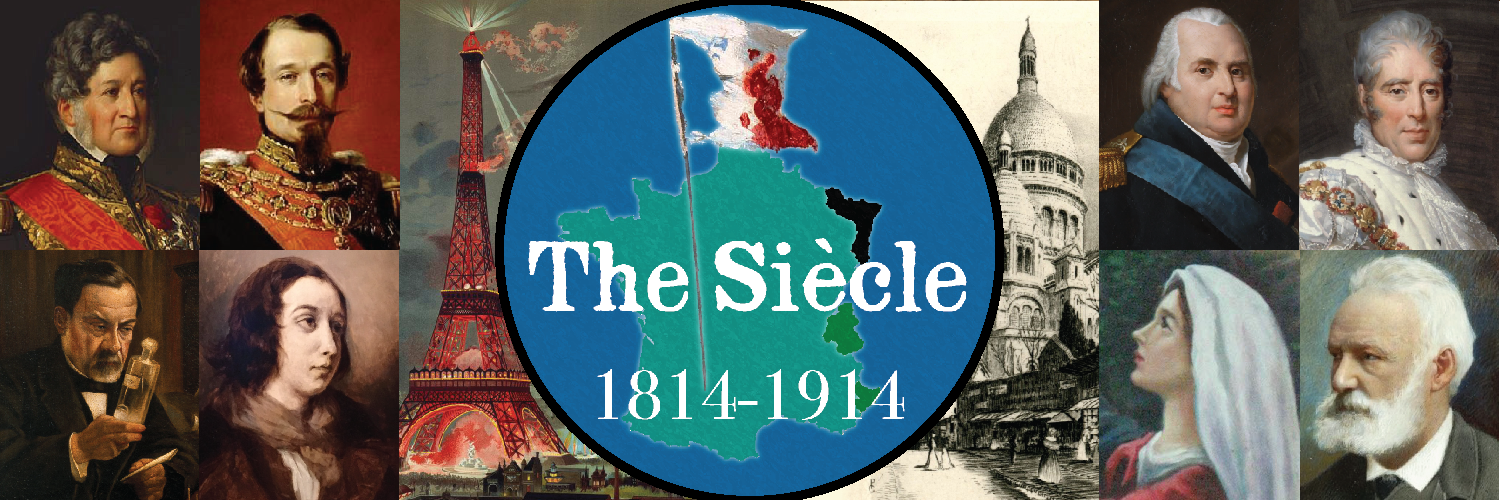Episode 22: French Press
There is a delightful anecdote from the Hundred Days that captures in a nutshell the fickle nature of newspapers in early 19th Century France. It consists of headlines from the Moniteur universel, the official French government-run newspaper, reporting on Napoleon’s advance on Paris as follows:
9th March, the [Cannibal]1 has quitted his den
10th, the Corsican Ogre has landed at Cape Juan
11th, the Tiger has arrived at Gap
12th, the Monster slept at Grenoble
13th, the Tyrant has passed through Lyons
14th, the Usurper is directing his steps towards Dijon, but the brave and loyal Burgundians have risen en masse and surrounded him on all sides
18th, Bonaparte is only sixty leagues from the capital; he has been fortunate enough to escape the hands of his pursuers
19th, Bonaparte is advancing with rapid steps, but he will never enter Paris
20th, Napoleon will, tomorrow, be under our ramparts
21st, the Emperor is at Fontainebleau
22nd, His Imperial and Royal Majesty, yesterday evening, arrived at the Tuileries, amidst the joyful acclamations of his devoted and faithful subjects.2
It’s my favorite story from the whole Hundred Days, with one very minor problem: it’s completely made up.
This is The Siècle, Episode 22: French Press.
I can say this anecdote is fictional with certainty because I have read the Moniteur edition from March 9, and March 10, and every other day that month, and the words of this delightful story do not occur anywhere within its pages.
Moreover, I can say this story is made up because I found the source that made it up, a different French newspaper, which printed this basic story — though with some key differences — in a March 25, 1815 issue, as a joke making fun of former loyalists to Louis XVIII. This sequence of supposed Moniteur headlines is a 200-year-old French version of people thinking an Onion article is a real news story.
But look, I get it: if anything falls under the category of “too good to check,” it’s a story as funny as this. And lots of very smart people have found this story too good to check over the years. In my research I’ve found it quoted unquestioningly everywhere from an 1841 travelogue by Alexandre Dumas to a 2004 article in the French newspaper Libération to an 1856 book of French grammar to a 2001 doctoral thesis about the occupation of France after the Napoleonic Wars. The joke was circulating as fact as early as a decade after 1815, well within the living memory of people who were involved in the actual newspapers in question — copied and recopied and translated like a chain email whose original source has long been lost.
I mention all this, however, not merely to play historical fact-checker. The Moniteur universel never printed the headlines so famously attributed to it — but the Moniteur was a real newspaper, and by looking at it and its sister papers, we can better understand the chaotic world of Restoration journalism.
I’m going to use the coverage of Napoleon’s return in March 1815, in the Moniteur and other papers, as our entry point into this topic. It’s one of the most dramatic stories any reporter could cover, and also happens to capture the nature and diversity of Restoration newspapers. But we’ll talk about newspapers over the entire period The Siècle has covered so far, as they’ve played a key role in all the events I’ve discussed, from the Chambre introuvable to the rise of Decazes to the assassination of the Duc de Berry and the war with Spain.
Le Moniteur universel
 We last talked about Napoleon’s escape from Elba way back in Episode 1, so I’ll start with a little refresher, this time with newspaper coverage in mind. Napoleon landed on the south coast of France on March 1, 1815. With the slow rate of travel at the time, news didn’t reach Paris until March 5, a Sunday. Napoleon had already reached the town of Gap, 120 miles or 196 kilometers inland, when an emergency dispatch for King Louis XVIII telling him of Napoleon’s landing came over the government’s optical telegraph line — a way of relaying messages by visual signals on towers, which I’ll discuss more in a future episode.3 Despite the secrecy of the message, news leaked out quickly, first as rumors that spread on Monday, March 64. But there was nothing about Napoleon in the March 6 edition of the Moniteur.5
We last talked about Napoleon’s escape from Elba way back in Episode 1, so I’ll start with a little refresher, this time with newspaper coverage in mind. Napoleon landed on the south coast of France on March 1, 1815. With the slow rate of travel at the time, news didn’t reach Paris until March 5, a Sunday. Napoleon had already reached the town of Gap, 120 miles or 196 kilometers inland, when an emergency dispatch for King Louis XVIII telling him of Napoleon’s landing came over the government’s optical telegraph line — a way of relaying messages by visual signals on towers, which I’ll discuss more in a future episode.3 Despite the secrecy of the message, news leaked out quickly, first as rumors that spread on Monday, March 64. But there was nothing about Napoleon in the March 6 edition of the Moniteur.5
Above: Keith Thomas. A 1944 illustration of communication by mechanical semaphore in 1800s France. Lines of towers supporting semaphore masts were built within visual distance of each other. The arms of the semaphore were moved to different positions, to spell out text messages. The operators in the next tower would read the message and pass it on. Public domain via Wikimedia Commons.
Instead, we find that first announcement in the March 7 edition — not the March 9 edition, as the Moniteur meme would have you believe. In that edition we find two official proclamations from the king. The first summons the Chamber of Deputies and Chamber of Peers back into session, for the vague reason that “the enemies of the fatherland base their hope on the devisions they are always trying to foment” and need to be beaten back by “the unassailable strength of an indestructible union.” The second announcement makes the reason for the the first clear, proclaiming: “Napoleon Bonaparte is declared a traitor and rebel for entering the department of the Var by force of arms.”6
Now we should pause here to talk about this March 7 edition of the Moniteur, because you might have some misconceptions about what an 1815 newspaper looks like. For one, remember the meme about the Napoleonic headlines? Forget that — newspapers didn’t have headlines in 1815. The closest thing they had were little section headings, telling you the general topic of the text to follow: in this edition, we have a heading reading “Proclamation” and one reading “Ordonnance du roi,” or “Royal Ordinance”; other headings declare that the text that follows discusses French literature, or news from the House of Lords in England.
Second, you might be under the impression that the return of Napoleon would be, well, front-page news. There again you’re mistaken. The royal announcements came on Page 3 of the four page issue. The front page — as well as the second page — was devoted to reports from abroad, some weeks out of date: a Feb. 25 dispatch from the Congress of Vienna, an update on British bond prices from March 2, details on debates in the British House of Commons from Feb. 24. Only after world news was finished did it present domestic news.
These four pages are laid out in three close-set columns, with tiny print. This was a consequence of the extreme cost of paper, which led editors at almost all papers at the time to squeeze as many words as they could onto as few pages as possible, and overall dispense with “all ideas of attractive layout.”7 There were no pictures of any kind. The columns were all continuous, like a modern newsletter — you read the first column top to bottom, then read the second column, and so on.
All these characteristics of the Moniteur were typical of French newspapers at the time. As historian Irene Collins writes, Parisian dailies “gave brief accounts of foreign developments, usually extracted from foreign newspapers, some snippets of home news and an account of proceedings in the Chambers, followed by book and theatre reviews which usually occupied one whole page out of the four.”8
If you’re curious about everything I’m describing, be sure to visit thesiecle.com/episode22, where I’ve posted pictures of these newspapers, as well as links to full PDFs you can browse online via Florida State University.
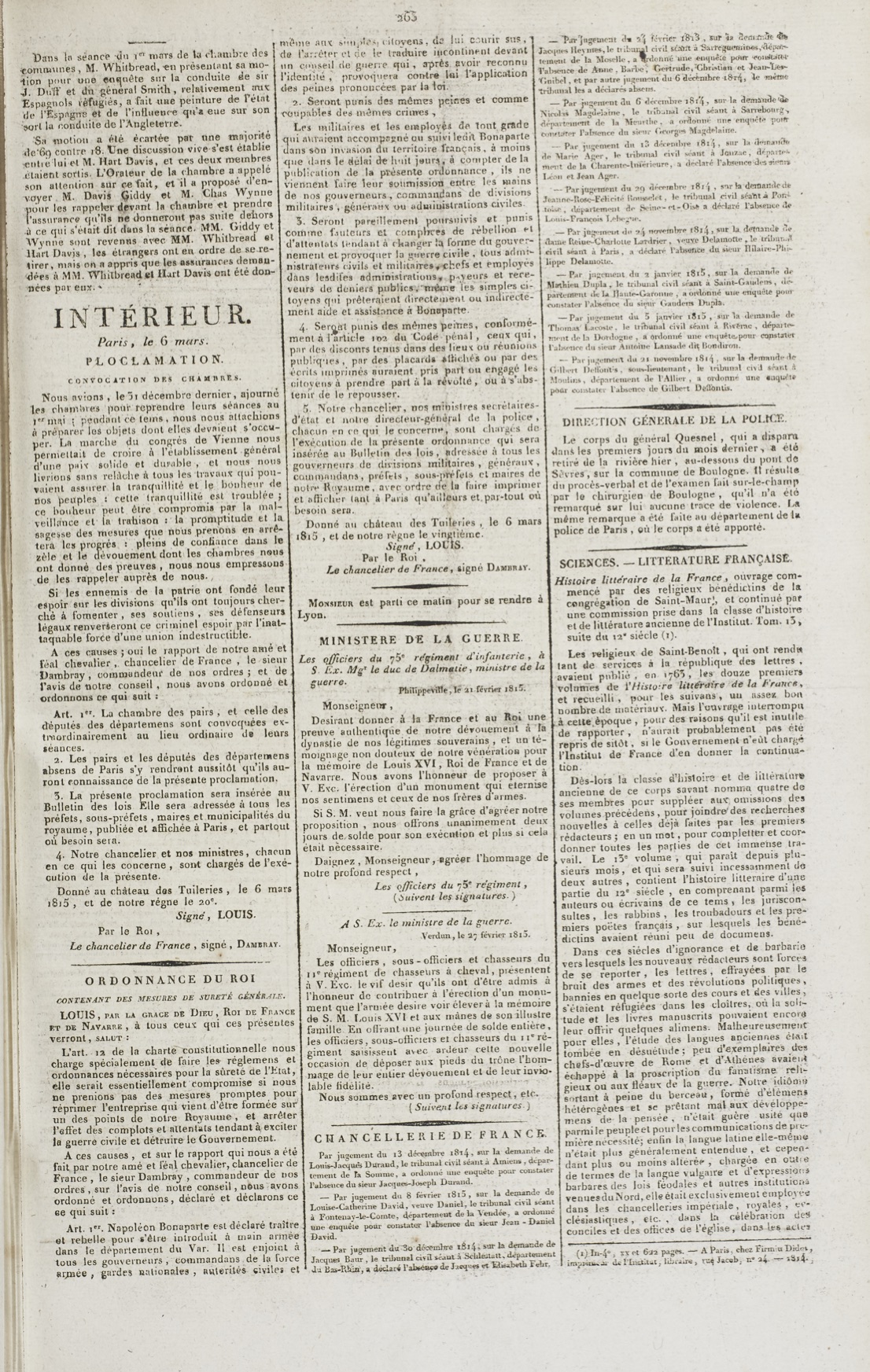
Le Moniteur universel, March 7, 1815. Accessed via DigiNole: http://purl.flvc.org/fsu/fd/FSU_NAPDC1M51815_Sem1_066.
The next day’s edition contains no mention of “Corsican ogres,” but it does contain actual news of Napoleon’s return, as opposed to simply official proclamations. “We were delayed until today in bringing the news of Bonaparte’s landing on the coast of Provence because the telegraphic dispatches which made it known didn’t give any more details,” the paper writes, apologetically, before proceeding to report out those details in a very matter-of-fact manner: “Bonaparte left Portoferraio [on Elba] on Feb. 26 at 9 p.m., in extremely calm weather… The ships dropped anchor in Golfe-Juan, near Cannes, on March 1…”9
This again comes on page 3 of a four page issue.
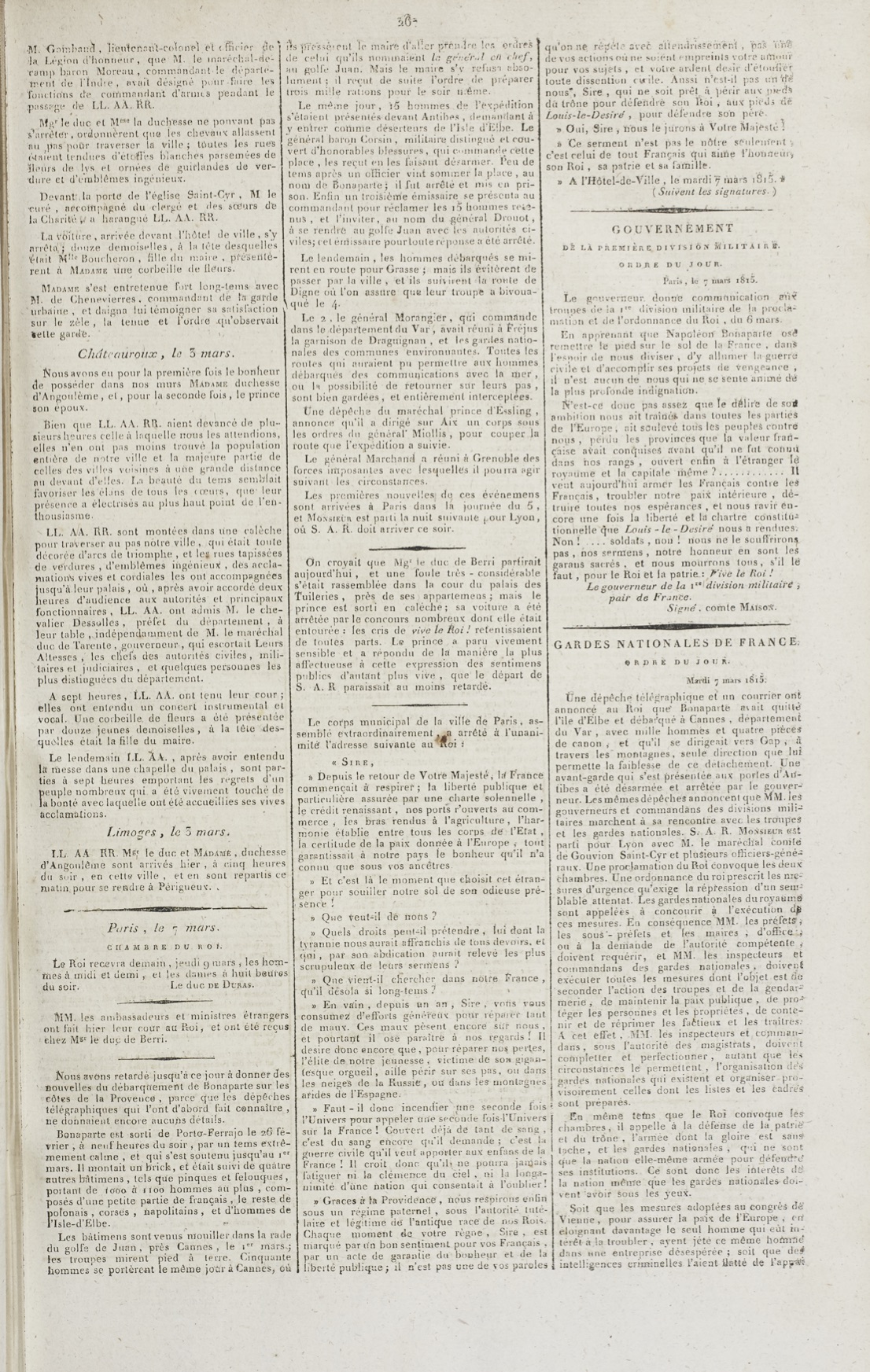
Le Moniteur universel, March 8, 1815. Accessed via DigiNole: http://purl.flvc.org/fsu/fd/FSU_NAPDC1M51815_Sem1_067.
The issues for the next few weeks are more of the same: reports of Napoleon’s advance, usually tucked inside, and often with a pro-Bourbon spin. The March 9 edition, after printing letters from officials in Provence about Napoleon’s progress, reports that Napoleon’s soldiers were selling their weapons and being arrested for public drunkenness. “We don’t know,” the article notes, “of a single man who took Bonaparte’s side or made the slightest display favorable to Bonaparte.”10
The March 10 edition contains notes of soldiers in the Paris garrison cheering the king.11 On March 11 the Moniteur notes that Napoleon was expected to enter Lyons, but quotes a prefect claiming that “the public spirit is good” and that people have “loyal sentiments.”12 March 13 contains letters from a range of marshals and officers declaring their loyalty to Louis.13
By this point in the crisis, the newspaper’s normal patterns are being shaken up. On March 13, the foreign news occupies less than a page, with domestic reports beginning partway down column three on page one. Instead of a page-plus of cultural coverage, there’s a single listing of theatrical performances at the very back of the newspaper. The March 15 edition dispenses with foreign and cultural news altogether — there’s just too much else going on.14 The editions of the 16th and 17th, among others, take pains to note Louis XVIII’s responses to the crisis: meeting with the chambers, appointing generals, issuing proclamations.15 By this point each issue devotes many columns to printing letters of support for the king from public officials and military officers. Napoleon is less than 200 kilometers from Paris at this point.16
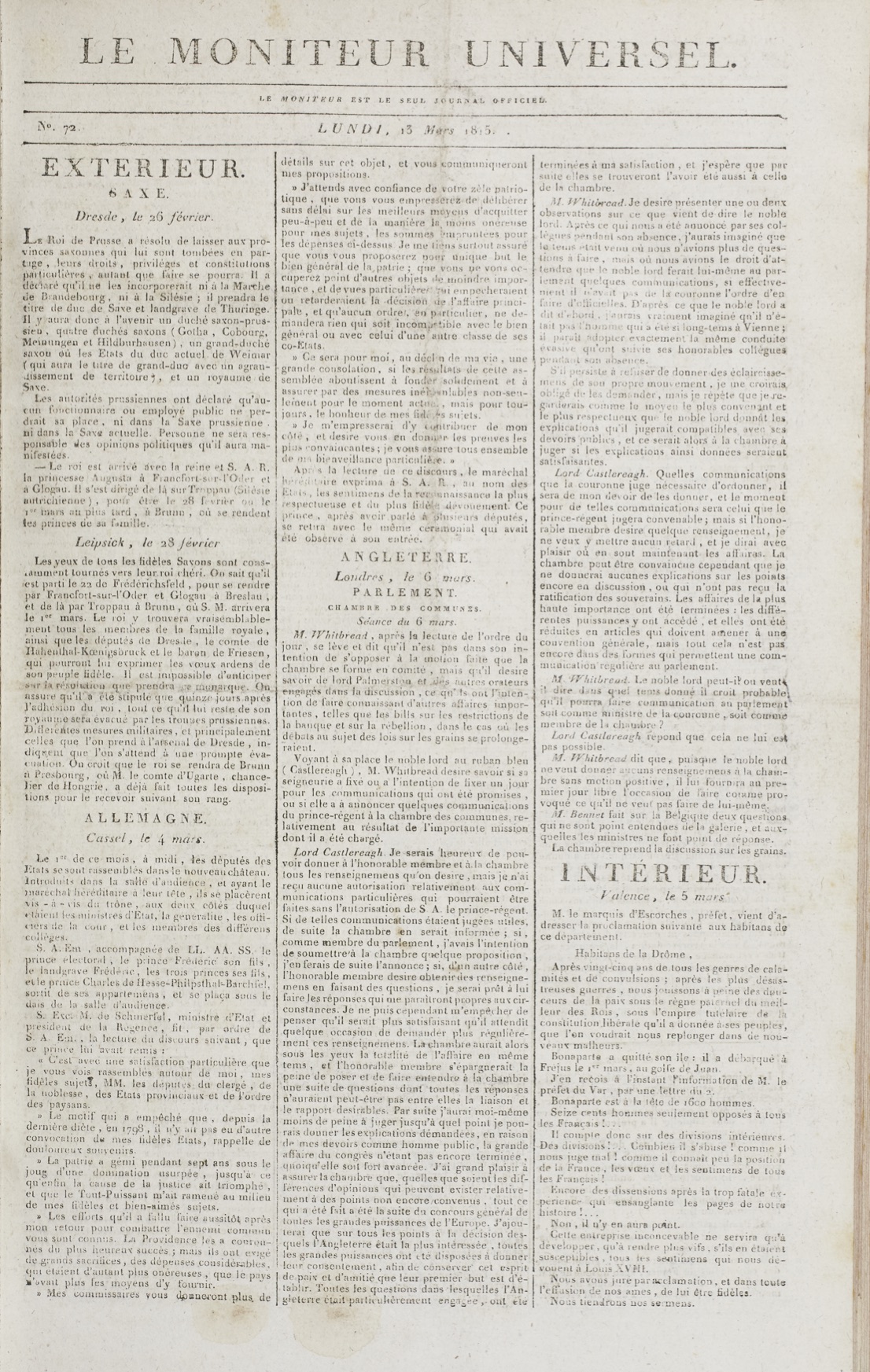
Le Moniteur universel, March 13, 1815. Accessed via DigiNole: http://purl.flvc.org/fsu/fd/FSU_NAPDC1M51815_Sem1_072.
As Napoleon closes in on Paris, the Moniteur increasingly stops reporting on his progress at all, until we get to the dramatic edition of Tuesday, March 21, 1815. This edition leads with domestic news:
The King and the princes left in the night. His Majesty the Emperor arrived this evening at 8 p.m. at the Tuileries Palace. He entered Paris at the head of the same troops that had been sent to block his way in the morning.
The rest of the issue then prints a host of Napoleon’s manifestos, issued over the preceding weeks but not published in France’s government-run newspaper until this day, when Napoleon and not Louis was running the government. It also includes a number of imperial decrees, and at the very end, after all of this, squeezes in some bond prices and a list of theatrical shows.17
Again, you can see pictures of this online at thesiecle.com/episode22.
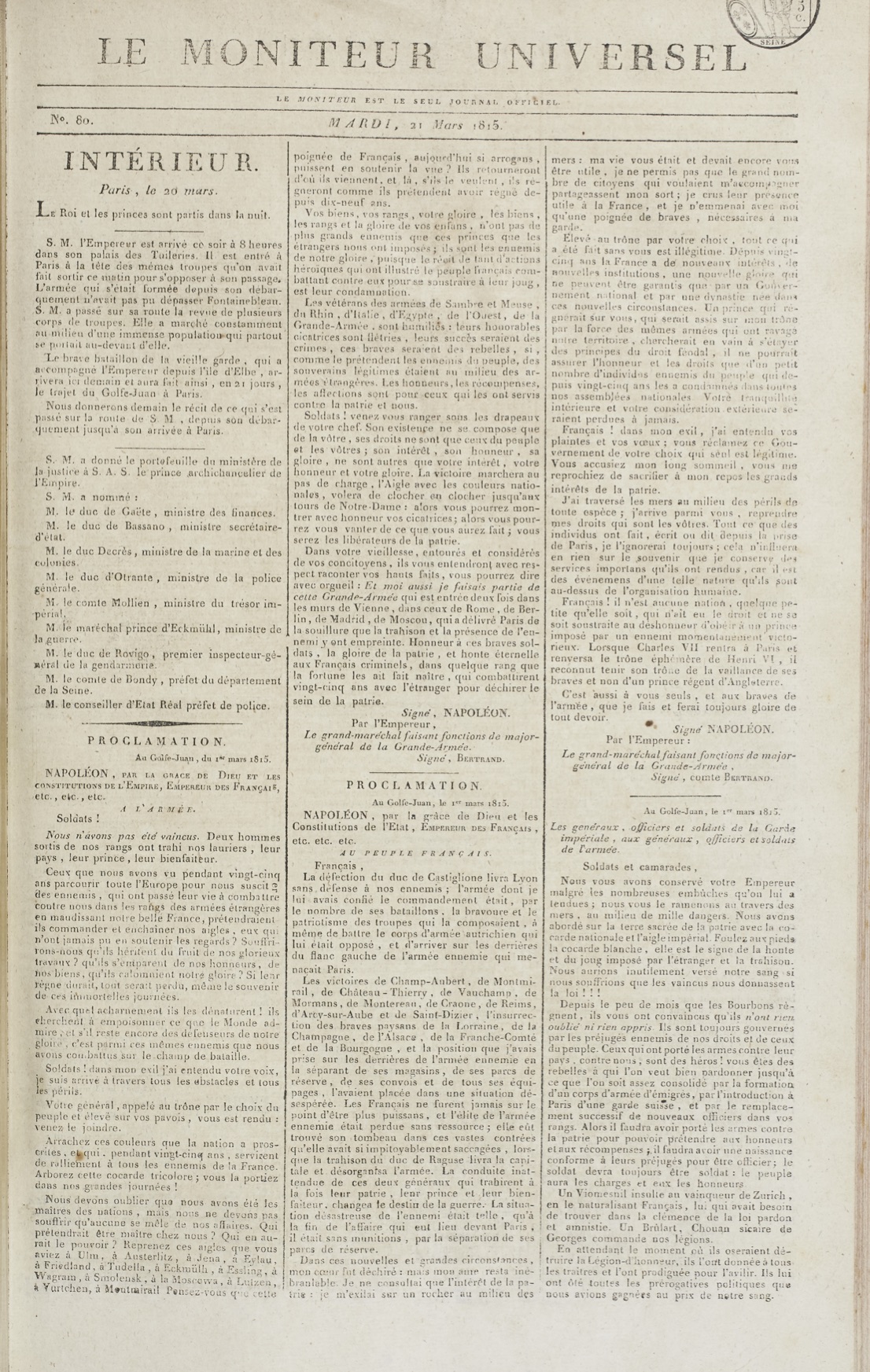
Le Moniteur universel, March 21, 1815. Accessed via DigiNole: http://purl.flvc.org/fsu/fd/FSU_NAPDC1M51815_Sem1_080.
You’ll note, of course, that the declaration of the March 21 Moniteur was not quite that of the meme, “His Imperial and Royal Majesty, yesterday evening, arrived at the Tuileries, amidst the joyful acclamations of his devoted and faithful subjects.” But neither was it entirely different. In a vague sense, the idea that the Moniteur’s headlines started out negative to Napoleon before becoming positive after he took over isn’t wrong, though every actual detail is.
But the Moniteur wasn’t the only newspaper in France. It wasn’t even the most popular newspaper. The Moniteur had only 3,000 subscribers in the whole country, though its reach was somewhat larger because other papers would reprint its articles.18 More popular than the Moniteur during the First Restoration were a liberal paper, the Censeur, with around 4,500 subscribers; the royalist Gazette de France with 6,290, and the most popular of them all, the Chateaubriand-inspired Journal des débats, with around 23,000. An annual subscription to a daily newspaper at this time cost between 50 and 60 francs, which was affordable for middle-class households and actually several times less than the cost of newspaper subscriptions in London.19
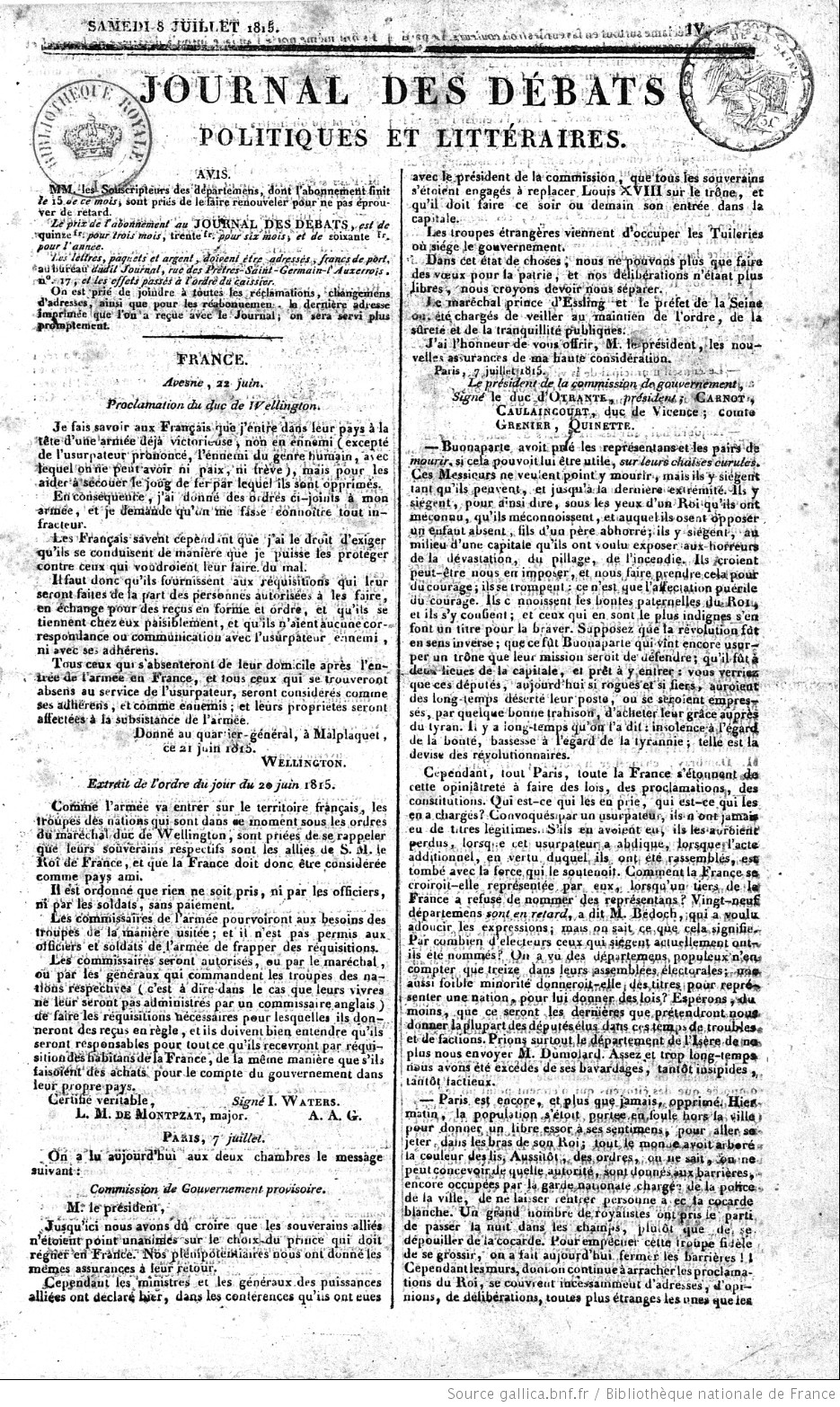
Journal des débats politiques et littéraires, July 8, 1815. Public domain via Bibliothèque nationale de France.
Le Nain Jaune
All of these papers were subject to censorship, run by the Paris police. Each paper had a commissaire assigned, who could visit its offices several times a day to inspect the articles, and force papers to withdraw any article they chose. To get around this oversight, many papers who wanted to criticize the government would publish periodically rather than daily, since periodicals faced less vigorous censorship.20 One such example was a small but significant periodical, Le Nain Jaune, roughly translated as “The Yellow Dwarf.” This paper was distinguished by three main characteristics: it was Bonapartist in its politics, it was irreverent in its tone, and once per month it published political cartoons, referred to as “caricatures,” to accompany its text.
One particularly famous example of all these tendencies came in February 1815, when it published a cartoon depicting the “Order of the Candle Snuffer,” an imaginary secret society who all wear candle-snuffers on their head. Since in French “lumière” meant both “light” and “enlightenment,” an order of people dedicated to extinguishing “lumière” was a satirical attack on reactionaries who wanted to turn back the clock to the ancien régime. This was subtle enough to make it past the censors, and for the next century or so after the candle-snuffer became a common symbol used to attack right-wing French politicians.21 Visit thesiecle.com/episode22 to view this cartoon.
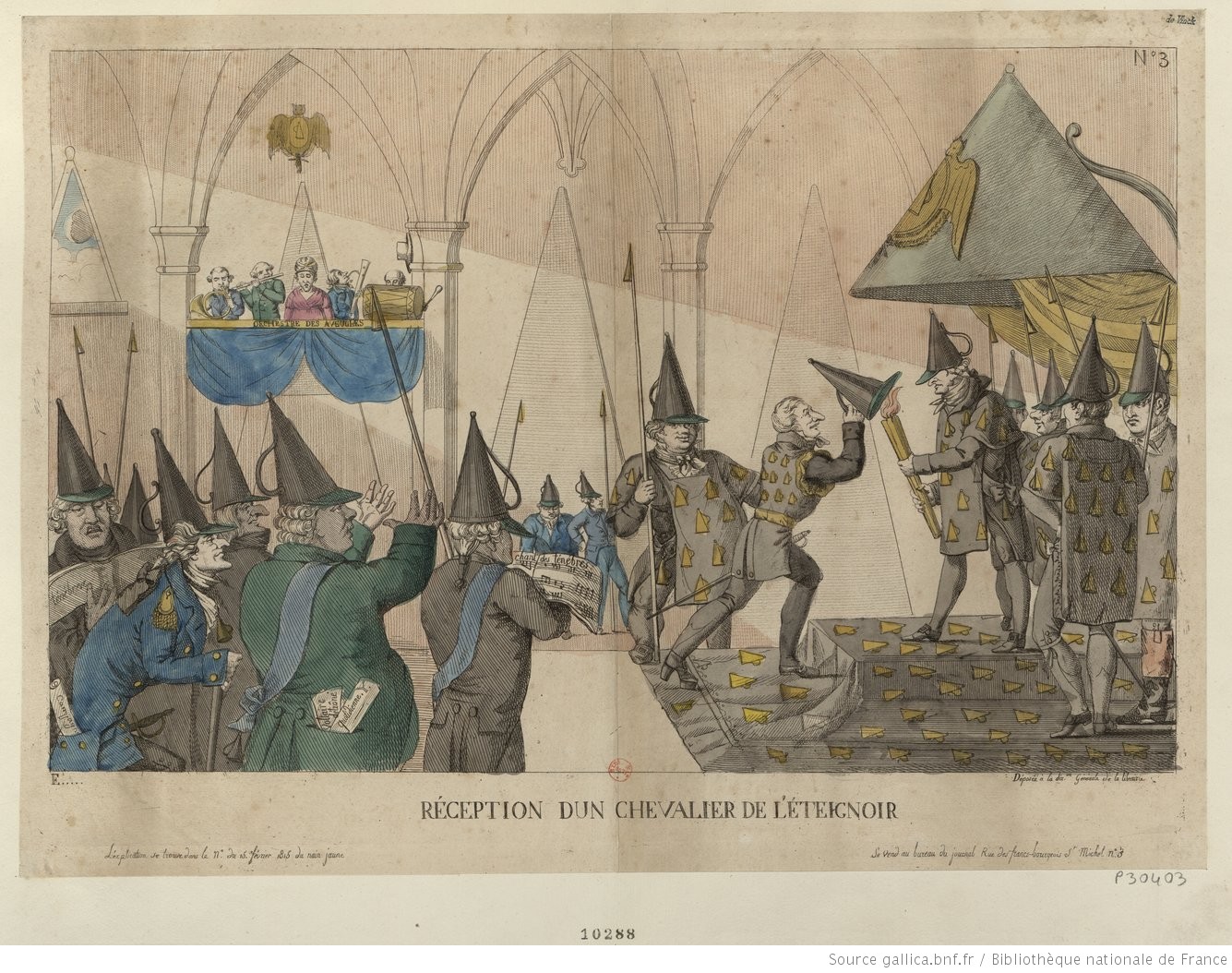
“Réception D’Un chevalier De L’Eteignoir,” 1815. Public domain via Bibliothèque nationale de France.
This Bonapartist paper making fun of royalists had a surprising fan: King Louis XVIII. Though generally opposed to freedom of the press, Louis also liked to be informed, and read opposition newspapers as well as those supporting him.22 When one of his relatives reproached him for subscribing to Le Nain Jaune, he supposedly responded, “It teaches me many things neither you nor anyone else would dare tell me.” But Louis also loved satire, and went beyond just reading Le Nain Jaune for information — he read it for amusement, and also, remarkably, probably actually submitted anonymous articles to it for publication, using a drop-box the paper set up.23
Le Nain Jaune did not return the love. In early March, 1815, during Napoleon’s March on the capital, the paper was subject to censorship, and often simply reprinted articles from the Moniteur.24 But the March 25 edition, after Napoleon’s return, begins with a series of exuberant exclamations: “The Emperor in Paris — Freedom of the press: Long live the Emperor!” After that comes a note from the editors to their subscribers, explaining that it had been “mutilated by the censor” and “obliged to accede to the force of circumstance” and to the “servile copyists of the Moniteur.”25 You’ll recall that during the Hundred Days, Napoleon struck a more liberal tone, and this included ending all censorship — including hostile papers as well as supporters like Le Nain Jaune.26 Thus liberated, the paper’s editors declared, Le Nain Jaune had “regained its gaiety.”
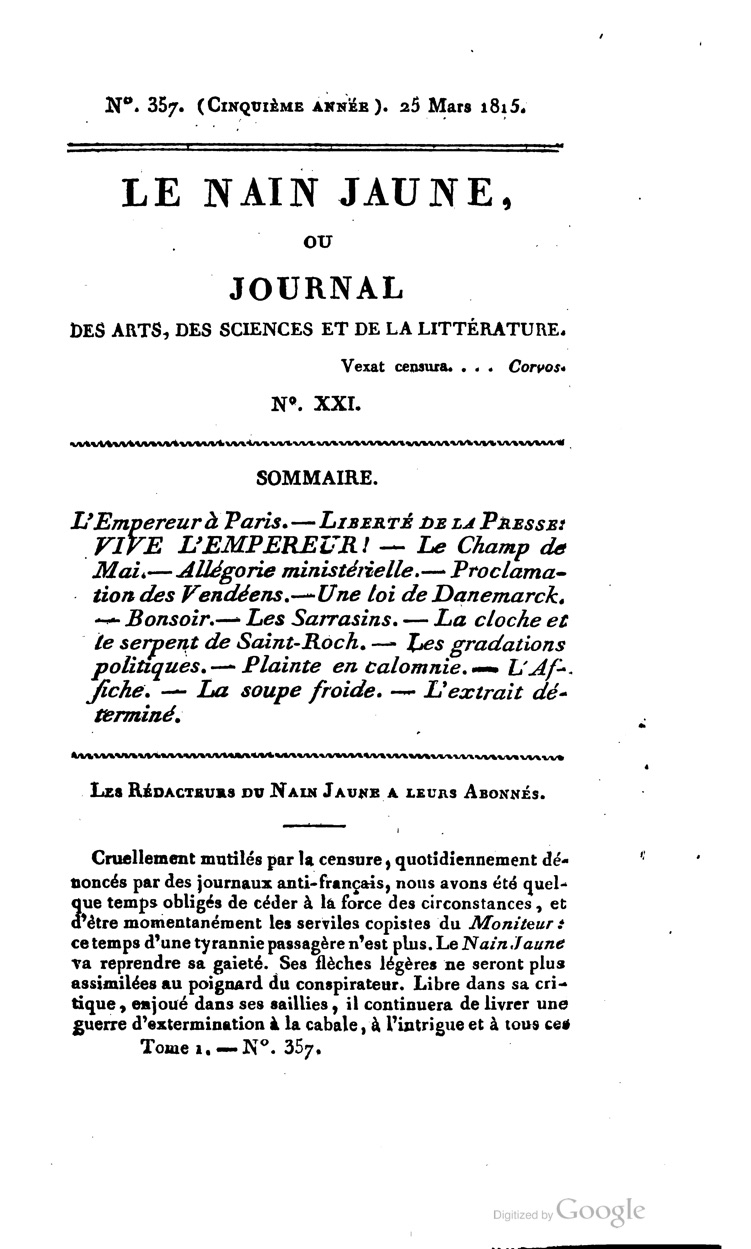
Le Nain Jaune, March 25, 1815.
It then demonstrated it that same issue, by running a short item under a section called “Sounds of the City”: a story about the supposed conversation between two soldiers of Louis XVIII, one of whom had just come to Paris from the country and was completely out of touch with the news. His better-informed friend filled him in, in a passage I will quote at length, via my own rough translation:
On the 25th of February the exterminator signed a treaty of alliance with someone unknown. On the 26th the Corsican left the island of Elba. On the 30th Buonaparte landed at Cannes with 600 men. On March 4 General Bonaparte seized Grenoble. On the 11th, Napoleon made his entrance into Lyon. Yesterday the Emperor was received at Fontainebleau to cheers. And His Imperial and Royal Majesty is expected in the Tuileries Palace tomorrow, March 20, the anniversary of the birth of His Majesty the King of Rome.27
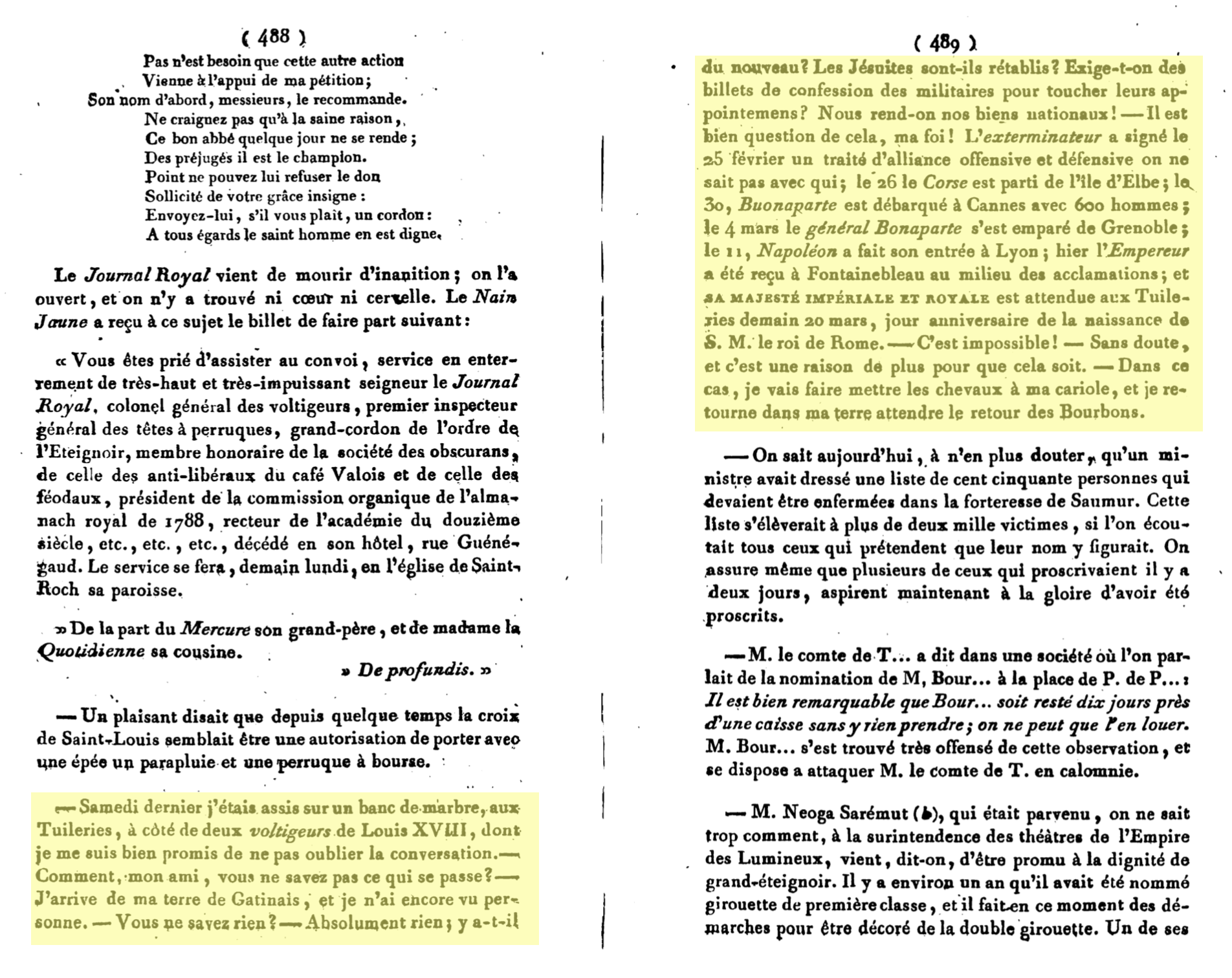
Le Nain Jaune, March 25, 1815. Highlights added.
You can see how this short joke is the original form of the famous headline meme that was soon making its way around Europe in the form we recognize it today. It was likely submitted by an anonymous reader through the paper’s dropbox — though in this case, probably not the deposed Louis.
Censorship
But Le Nain Jaune’s freedom from the censor did not long outlive Napoleon’s reign. It was a victim of the post-Waterloo repression I talked about in Episode 5: The White Terror. Newly imposed censorship required newspapers to get prior authorization to publish, which included minute specifications of what topics papers were allowed to cover or not — newspapers weren’t even allowed to publish schedules of upcoming concerts unless they had prior authorization to do so. The rules were opaque, which left considerable leeway for the police to choose how to enforce them. Journalists who violated these laws could be held criminally liable.28 In 1817, Élie Decazes said that five newspapers had been suppressed entirely, and 20 had received temporary suspensions. Among the five suppressed papers was Le Nain Jaune, whose editor fled to Belgium and continued the paper in exile for a while as Le Nain Jaune réfugié, or “The Yellow Dwarf Refugee.”29
This censorship regime lasted for a few years after Waterloo, during which the new liberal daily paper Constitutionnel was suspended three times in its first five months, and was often forced to avoid writing about politics altogether in favor of covering gossip and crime — though it often used innuendo and story selection to push its point of view, for example by regularly featuring human-interest stories about noble former Napoleonic soldiers.30 But in 1819, as I covered in Episode 14, Decazes’ government passed a new press law that largely abolished censorship. I’ll just quote myself here: under the new law,
prior authorization and prior restraint were abolished, replaced by a system by which newspapers had to submit a deposit of 10,000 francs and a declaration of responsibility by two editors, to aid in prosecuting any legal action after the fact. More generally, the law established a liberal principle: “An opinion… does not become a crime by becoming public.” Under this principle, it was still a crime to incite violence, to libel someone, etc., but gone was the old idea that there were some opinions that it was alright to share among friends but illegal to publish in a newspaper.31
This liberalization produced a flurry of new newspapers of all political stripes, but the freedom was to be short-lived. As I discussed in Episode 15, after the Duc de Berry’s assassination, France passed what were dubbed the “exceptional laws,” which included a reimposition of censorship. That law again required newspapers to get prior authorization to publish, and set up vigorous — though under-staffed — committees of censors.
The committee of censors in Paris put forth an interesting criteria for what was and wasn’t allowed to be published. Opinions could be debated freely, but “facts” were “above discussion.” Among the “facts” defined by the committee as unacceptable to discuss were religion and the institution of monarchy.32
But in practice the censorship was applied unevenly. Ultra-royalists expected the censorship would target the left, but howled when the government sometimes censored them as well. Dissident papers on the left and right tried various different methods of evading the censors, including using the typesetting to give certain words emphasis that the censors hadn’t noticed, printing rejected articles as pamphlets with the title “censorship rejects,” and merging with papers of similar politics to create more financially secure newspapers able to survive brushes with the law.33 Others replaced offending words with dots rather than changing them altogether — a practice that usually left “the original meaning obvious.” When censors started striking whole sections, these papers ran blank columns in protest. Several newspapers shut down altogether rather than comply with the censors.34
The original 1820 censorship bill passed in part because it was temporary, with a one-year expiration date. In 1821, censorship got another temporary extension. But that was all the ministry would get — in December 1821, an odd coalition of liberals and ultra-royalists combined to defeat another censorship bill. The new prime minister, Villèle, was forced to lift most of the restrictions on daily newspapers; as compensation he toughened up France’s libel laws, and kept censorship of caricatures, which were seen as more dangerous than the printed word, and more accessible to the many French people who couldn’t read.35
The readers
So who were these people reading French papers? That’s a tricky question because we need to distinguish between subscribers and readers. I mentioned earlier that newspaper prices in France were cheaper than those of London, and affordable for the upper middle class. But they weren’t affordable for the masses, and that shows up in subscriber numbers. In 1826, the 14 major political newspapers in Paris had combined subscriptions of 65,00036, at a time when the country had about 32 million people and Paris the better part of one million.37 But not all those subscribers were individuals. In many towns people formed reading clubs, who would pool their money to subscribe to a paper, which members could then read in a special reading room. Some saw 100 or more visitors per day.38 More popular still were cafés, whose owners found that a newspaper subscription or two would bring in paying customers to read and debate the news. The liberal paper Constitutionnel in 1825 had about 20,000 subscribers — but one police report estimated that “some copies in the cafés of Paris were read by fifty or sixty people.”39
But all told, even with this broader audience, the papers of the Restoration did not have mass audiences. Newsprint was too expensive to make papers cheaply, and their content was aimed at an elite audience: lots of politics, dispatches from foreign countries, and literary news. There were rarely any of the later innovations papers came up with to appeal to mass audiences: cartoons, fiction, celebrity gossip and news of sensational crimes. It’s not that these things didn’t exist in 1820s France. They did. It’s just that they usually weren’t in daily newspapers. If you wanted to see a political cartoon or the picture of the Duc de Berry’s assassin, you might buy a stand-alone print.40 If you wanted crime news, there were dedicated news sheets called canards 41. And of course there were numerous political pamphlets offered up for sale on one subject or another. All these could be quite popular, much more so than the daily newspapers that so preoccupied political elites. But the very fact that the political elites cared about the newspapers made them important, especially in a country with a property-based voting system.
One reason that these other forms were often more popular than daily newspapers is because you could buy a caricature, a canard or a pamphlet on the street. Newspapers at the time were subscription-only, with no street sales. Among other things, this meant that they were unable to capitalize when a big news event increased demand for their news.42
A parliamentary debate in 1827 gives us a look at the finances for one of larger papers of the period: the Constitutionnel. In 1826 it had around 20,000 subscribers, who brought in gross receipts of nearly 1.4 million francs. About one-third of that revenue, 450,000 francs, went directly to the government, in the form of France’s stamp tax.43 Postage and delivery cost another 102,000. Editorial, administrative and other expenses totalled 394,000 francs, which left about 375,000 francs in net profit — to be divided among 10 shareholders.44 That’s still a lot of money, but maybe not that much given the risks involved, especially given the omnipresent censors with their power to suspend, shut down or criminally charge newspapers. And of course this profit comes from one of the most popular newspapers in the country; many others had far fewer subscribers.
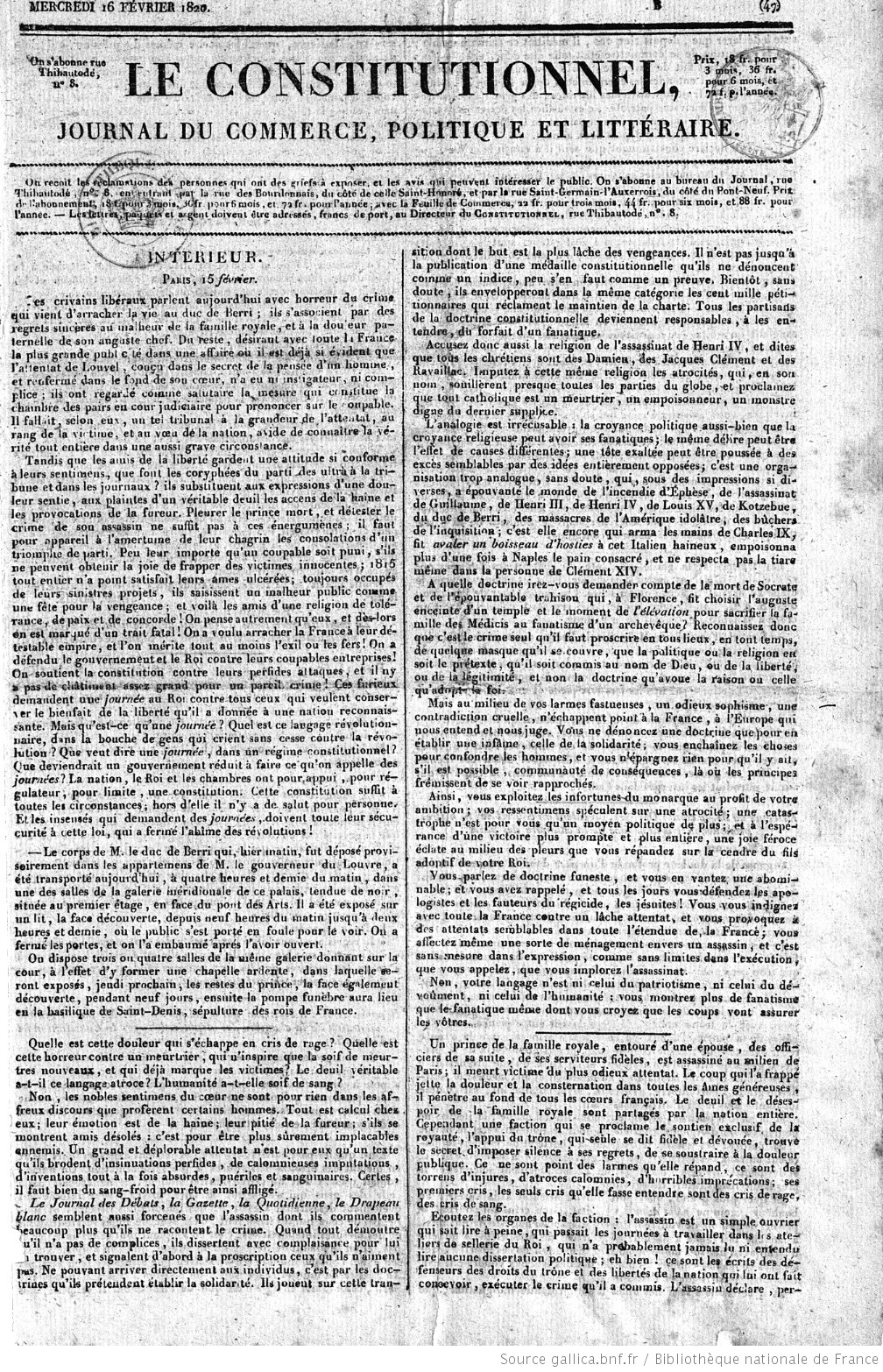
Le Constitutionnel, journal du commerce, politique et littéraire, February 16, 1820. Public domain via Bibliothèque nationale de France. This edition covers the death of the Duc de Berri.
You might notice that I didn’t mention advertising as a source of revenue. That’s because it wasn’t. French newspapers of the time rarely ran ads, and if they did it was a notice from the publisher of a book “whose political principles were in line with those of the newspaper.” Newspapers had to earn their money from subscriptions alone — or from subsidies by a wealthy benefactor hoping to use the paper to promote their politics.
Politics
Other than some small commercial papers, French newspapers at the time were almost all political — usually sponsored by someone with money who wanted to promote their point of view. The Censeur européen was aligned with the values of the Marquis de Lafayette, while fellow liberal grandee Benjamin Constant was associated with the Minerve.45 A group of ultra-royalists in 1818 founded a new paper, the Conservateur, and hired Chateaubriand to be their editor — which brought both quick success from the statesman’s brilliant pen, and constant headaches from his huge salary and touchy attitude.46 A year later a different group of ultra-royalists founded the Drapeau blanc, which took a more incendiary tone. The ultra political leader, Villèle, “believed that the violence of the Drapeau was doing more harm than good to the party,” but since sales kept going up the publisher refused to change its tone.47
Against these papers of the left and right, the ministries of Richelieu, Decazes and Villèle struggled to promote their views in print. We’ve already seen how the government paper, the Moniteur, had a limited number of subscribers. In general, any paper that supported the government was “automatically assumed to be dull”, and they were hardly ever seen in cafés or libraries. In 1825, the police reported that the six opposition papers in Paris had twice as many subscribers as the six ministerial papers.48 When Decazes wanted to put something in the press, he didn’t use the papers that supported his ministry at all — he bribed the Times of London to run letters attacking the Comte d’Artois and other Ultras, reports which then trickled back into France with the prestige of the non-dull foreign papers attached.49
Faced with the failure of ministries both left- and right-wing to find support in the domestic press, Villèle’s government finally resorted to a bit of skullduggery: they would use government money to secretly buy up the opposition newspapers. This scheme achieved some limited success — using as much as 3 million francs in public funds, the ministry secretly bought up first a liberal paper, the Tablette universelles, which suddenly changed its political position before collapsing a few months later. A half-dozen other papers were bought up and handled with more subtlety — papers like the Drapeau blanc, after it was under ministry ownership, were allowed to criticize minor issues and low-ranking officials, but on the big issues of the day they were expected to fall in line. Despite these precautions the whole affair soon came to light when the publisher of one purchased paper, upset at the change of direction, filed lawsuits that exposed everything. The ministry was left with egg on its face as the whole scheme collapsed.50
On top of that, opposition newspapers found a loophole that made schemes like this one pointless. The value of eliminating an opposition paper was wrapped up in the fact that new newspapers needed royal permission to start. Eliminate one opposition paper and any replacements could be denied. But a clause in the law let papers founded before January 1822 escape that requirement for permission. Not a huge deal, perhaps, until some dissidents came up with the idea of buying the rights to a defunct newspaper, the Aristarque, and starting it up again on the theory that since it had existed before 1822, it didn’t need new permission. The government seized the first few issues — but the Aristarque’s new owners won on appeal. Since there had been plenty of newspapers over the past half-decade or so that had closed down but might qualify for the same loophole, the ministry found itself at a loss.51
As we catch up with our narrative, we find French journalism on the verge of some big changes. New mechanical presses were a few years away from widespread adoption, making it cheaper and faster to print newspapers than under the old hand-presses that dominated the Restoration period.52 Similarly, the new technique of lithography made it much easier to print images; after 1830 newspapers will begin to more regularly include pictures and caricatures, instead of simply walls of text.53 The Journal des Débats will begin selling advertisements in 1827, followed eventually by other French papers.54
 The practice of journalism will evolve, too. The papers of this period largely printed excerpts from foreign papers, submitted letters, and political and literary essays. But in 1822, a young French writer for the Constitutionnel did something today that would seem unremarkable for a journalist with a war brewing: he took a trip down to Spain to write about tension there between Spain’s revolutionary government, conservatives resisting it, and the French corps of observation on the frontier. In the early 1820s, this was a novelty, and it made the reputation of the journalist, a 25-year-old lawyer and writer named Adolphe Thiers.55
The practice of journalism will evolve, too. The papers of this period largely printed excerpts from foreign papers, submitted letters, and political and literary essays. But in 1822, a young French writer for the Constitutionnel did something today that would seem unremarkable for a journalist with a war brewing: he took a trip down to Spain to write about tension there between Spain’s revolutionary government, conservatives resisting it, and the French corps of observation on the frontier. In the early 1820s, this was a novelty, and it made the reputation of the journalist, a 25-year-old lawyer and writer named Adolphe Thiers.55
Right: “Young Adolphe Thiers.” Public domain via Wikimedia Commons.
For now, I want to close by circling back to where we began. The details of the joke about changing press coverage as Napoleon advanced on Paris might all be made up, but the joke has clearly resonated. Part of it is timeless humor about how the truth can bend to self-interest. But more specifically, as we’ve seen, French newspapers had a complicated relationship with the truth and with government censors during the Restoration. They spent much of the period battling, with varying degrees of success, to maintain the freedom to print what they want — even if what they wanted to print often fell short of what we might consider “journalism” today.
We’ll have plenty more to say about the role of journalism in future episodes, as newspapers and censorship alike will continue to be major factors in French political and cultural life. Next time, we’ll be picking our narrative back up in the early 1820s, after the passage of the “exceptional laws.” With legal means of gaining power seemingly blocked off, France’s liberals and Bonapartists will embrace conspiracy with a new gusto — and they’ll find role models right across the border.
Join me next time for Episode 23: Charbonnerie.
-
Literally “Anthropophagus,” a Latin-derived synonym for cannibal. ↩
-
“Napoleon’s march on Paris as reported via newspaper headlines,” The Museum of Foreign Literature, Science, and Art, Volume XVIII, 1831, via Wikisource. Note that the word “headline” in the title is anachronistic and a later application to this text. Use of the word “headline” to refer to the title of a newspaper article dates only from the year 1890. The original French, in at least one version, is as follows:
- L’anthropophage est sorti de son repaire.
- L’ogre de Corse vient de débarquer au golfe Juan.
- Le tigre est arrivé à Gap.
- Le monstre a couché à Grenoble.
- Le tyran a traversé Lyon.
- L’usurpateur a été vu à soixante lieues de la capitale.
- Bonaparte s’avance à grands pas, mais il n’entrera jamais dans Paris.
- Napoléon sera demain sous nos remparts.
- L’empereur est arrivé à Fontainebleau.
- Sa Majesté Impériale et Royale a fait hier son entrée en son château des Tuileries au milieu de ses fidèles sujets.
Alexandre Dumas, Une Année à Florence (Paris: Michel Lévy Frères, Librarires-Éditeurs, 1861), 58. ↩
-
In 1815, the optical telegraph line ran from Paris to Lyons but not down to Provence, where Napoleon landed. The message was dispatched on March 3, first overland from Marseilles to Lyons and then via telegraph to Paris. Paul Britten Austin, 1815: The Return of Napoleon (Barnsley: Frontline Books, 2002), 117-8. ↩
-
On March 6, Napoleon won over the first group of soldiers sent to stop him in a dramatic showdown in the village of Laffrey. ↩
-
Le Moniteur universel, March 6, 1815. Accessed via DigiNole: http://purl.flvc.org/fsu/fd/FSU_NAPDC1M51815_Sem1_065. ↩
-
Le Moniteur universel, March 7, 1815. Accessed via DigiNole: http://purl.flvc.org/fsu/fd/FSU_NAPDC1M51815_Sem1_066. ↩
-
Irene Collins, The Government and the Newspaper Press in France, 1814-1881 (London: Oxford University Press, 1959), 49. ↩
-
Collins, The Government and the Newspaper Press in France, 6. ↩
-
Le Moniteur universel, March 8, 1815. Accessed via DigiNole: http://purl.flvc.org/fsu/fd/FSU_NAPDC1M51815_Sem1_067. ↩
-
Le Moniteur universel, March 9, 1815. Accessed via DigiNole: http://purl.flvc.org/fsu/fd/FSU_NAPDC1M51815_Sem1_068. ↩
-
Le Moniteur universel, March 10, 1815. Accessed via DigiNole: http://purl.flvc.org/fsu/fd/FSU_NAPDC1M51815_Sem1_069. ↩
-
Le Moniteur universel, March 11, 1815. Accessed via DigiNole: http://purl.flvc.org/fsu/fd/FSU_NAPDC1M51815_Sem1_070. ↩
-
Le Moniteur universel, March 13, 1815. Accessed via DigiNole: http://purl.flvc.org/fsu/fd/FSU_NAPDC1M51815_Sem1_072. ↩
-
Le Moniteur universel, March 15, 1815. Accessed via DigiNole: http://purl.flvc.org/fsu/fd/FSU_NAPDC1M51815_Sem1_074. ↩
-
Le Moniteur universel, March 16, 1815. Accessed via DigiNole: http://purl.flvc.org/fsu/fd/FSU_NAPDC1M51815_Sem1_075. Le Moniteur universel, March 17, 1815. Accessed via DigiNole: http://purl.flvc.org/fsu/fd/FSU_NAPDC1M51815_Sem1_076. ↩
-
Andrew Roberts, Napoleon: A Life (New York: Viking Penguin, 2014), 737. ↩
-
Le Moniteur universel, March 21, 1815. Accessed via DigiNole: http://purl.flvc.org/fsu/fd/FSU_NAPDC1M51815_Sem1_080. ↩
-
Collins, The Government and the Newspaper Press in France, 21, 13. ↩
-
Collins, The Government and the Newspaper Press in France, 6-7. ↩
-
Collins, The Government and the Newspaper Press in France, 5, 7. ↩
-
Robert Justin Goldstein, Censorship of Political Caricature in Nineteenth-Century France (Kent, Ohio, and London: The Kent State University Press, 1990), 102. ↩
-
Philip Mansel, Louis XVIII, Rev. ed. (Phoenix Mill: Sutton, 1999), 182, 316. ↩
-
Collins, The Government and the Newspaper Press in France, 8. Goldstein, Censorship of Political Caricature in Nineteenth-Century France, 102. ↩
-
For example, both the March 16 Moniteur and the March 20 Nain Jaune run an identical article alleging Napoleon plans to bring anarchy to France because his forces are insufficient to take power otherwise. Le Moniteur universel, March 16, 1815. Accessed via DigiNole: http://purl.flvc.org/fsu/fd/FSU_NAPDC1M51815_Sem1_075. Le Nain Jaune, March 20, 1815. ↩
-
Le Nain Jaune, March 25, 1815. ↩
-
Roberts, Napoleon: A Life, 745. ↩
-
Le Nain Jaune, March 25, 1815. ↩
-
Sylvia Neely, Lafayette and the Liberal Ideal, 1814-1824: Politics and Conspiracy in an Age of Reaction (Carbondale and Edwardsville: Southern Illinois University Press, 2004), 71 ↩
-
Collins, The Government and the Newspaper Press in France, 10-11. ↩
-
Collins, The Government and the Newspaper Press in France, 12, 17. ↩
-
Guillaume de Bertier de Sauvigny, The Bourbon Restoration, translated by Lynn M. Case (Philadelphia: The University of Pennsylvania Press, 1966), 161-2. ↩
-
Collins, The Government and the Newspaper Press in France, 32. ↩
-
Sauvigny, The Bourbon Restoration, 169. David Skuy, Assassination, Politics and Miracles: France and the Royalist Reaction of 1820 (Montreal & Kingston: McGill-Queen’s University Press, 2003), 145. ↩
-
Collins, The Government and the Newspaper Press in France, 31-33. ↩
-
Collins, The Government and the Newspaper Press in France, 35-7. Goldstein, Censorship of Political Caricature in Nineteenth-Century France, 109. ↩
-
Sauvigny, The Bourbon Restoration, 293. ↩
-
B.R. Mitchell, ed., European Historical Statistics: 1750-1975. 2nd Rev. Ed. (London: The MacMillan Press Ltd, 1981), 30, 70. ↩
-
Collins, The Government and the Newspaper Press in France, 19-20, 28-29. Sauvigny, The Bourbon Restoration, 293-4. ↩
-
Collins, The Government and the Newspaper Press in France, 19-20, 48. ↩
-
Goldstein, Censorship of Political Caricature in Nineteenth-Century France, 8. Skuy, Assassination, Politics and Miracles: France and the Royalist Reaction of 1820, 117. ↩
-
Thomas Cragin, Murder in Parisian Streets: Manufacturing Crime and Justice in the Popular Press, 1830-1900 (Lewisburg, Pennsylvania: Bucknell University Press, 2006), 23-28. ↩
-
Collins, The Government and the Newspaper Press in France, 42. ↩
-
Part of the purpose of the stamp tax, Collins writes, is that “newspapers should pay the expense involved in surveillance of them.” Collins, The Government and the Newspaper Press in France, 48. ↩
-
Sauvigny, The Bourbon Restoration, 294. ↩
-
Neely, Lafayette and the Liberal Ideal, 58-62, 72. ↩
-
Collins, The Government and the Newspaper Press in France, 20-21. ↩
-
Collins, The Government and the Newspaper Press in France, 26-7. ↩
-
Collins, The Government and the Newspaper Press in France, 47-8. ↩
-
Decazes reportedly paid as much as 10,000 francs per month for access to the Times. Collins, The Government and the Newspaper Press in France, 28. ↩
-
Collins, The Government and the Newspaper Press in France, 43-6. ↩
-
Collins, The Government and the Newspaper Press in France, 46-7. ↩
-
Collins, The Government and the Newspaper Press in France, 60, 72. ↩
-
Goldstein, Censorship of Political Caricature in Nineteenth-Century France, 126. ↩
-
Collins, The Government and the Newspaper Press in France, 88. ↩
-
J.P.T. Bury and R.P. Tombs, Thiers, 1797-1877: A Political Life (Boston: Allen and Unwin, 1986), 10-11. Reporting in person had other benefits for Thiers: his article predicted, accurately, that the French army would remain loyal to the Bourbons if asked to crush the Spanish liberals, at a time when most French liberals (and not a few French conservatives) had convinced themselves that activating the French army to crush the Spanish rebellion would lead to the soldiers overthrowing Louis, as Spanish soldiers had overthrown Ferdinand. I discussed all this in Episode 18. ↩
